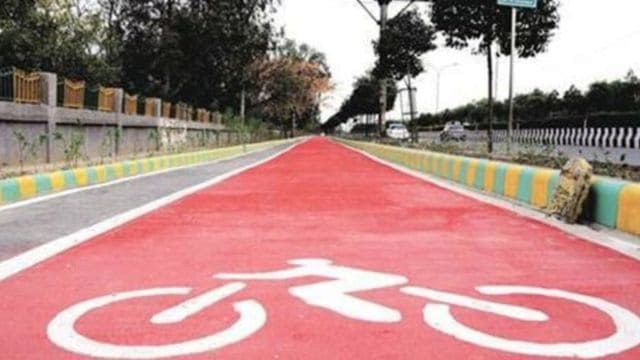MMRDA begins dismantling cycle tracks in Mumbai’s BKC to address traffic woes
MMRDA officials said dismantling and utility shifting work is being done as the cycle tracks remained largely unused, while vehicle volumes surged, particularly after the closure of the Sion Bridge.
 The cycle tracks, sanctioned in 2011 for BKC’s G-block, were designed as a 13-km network, with work beginning the following year. (Express Photo)
The cycle tracks, sanctioned in 2011 for BKC’s G-block, were designed as a 13-km network, with work beginning the following year. (Express Photo)The Mumbai Metropolitan Region Development Authority (MMRDA) began dismantling the cycle tracks in Bandra-Kurla Complex (BKC) and relocating underground utilities last week to make way for an additional car lane as part of a road-widening project.
The dismantling and utility shifting work, costing about Rs 25 crore, is being done in view of the worsening traffic situation, particularly after the closure of the Sion bridge. It will expand the current 2+2 lane configuration into 3+3 lanes.
The cycle tracks, sanctioned in 2011 for BKC’s G-block, were designed as a 13-km network, with work beginning the following year. By 2021, around 9 kilometres had been completed at a cost of nearly ₹60 crore.
However, in July, MMRDA decided to remove the tracks entirely within a month, citing the urgent need for additional road space.
According to MMRDA, BKC currently handles close to six lakh daily commuters, two lakh employees of the companies, and around four lakh visitors.
Officials said the cycle tracks remained largely unused, while vehicle volumes surged well beyond initial projections.
“This change is part of an overall traffic management strategy to ensure smoother vehicular movement and more efficient use of available road space. We are also looking at optimising traffic signal timings and circulation patterns,” an MMRDA officer said on Tuesday.
Officials estimate that the travel time during peak hours could fall from 25 minutes to 15 minutes, with signal wait times dropping from 10 minutes to about 7 minutes. Reduced idling is also expected to lower carbon emissions by up to 30 per cent in the area.
“For years, the cycle tracks remained empty while traffic piled up. After the additional lane opens, it should at least ease bottlenecks during rush hours,” the officer said.
MMRDA is also working with the Mumbai Traffic Police on a one-way circulation plan for BKC, based on a detailed study of peak-hour movements.












